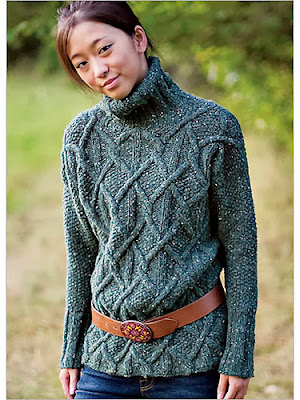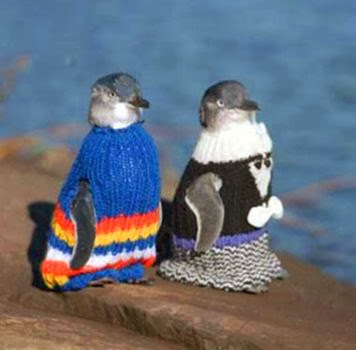The Spring/Summer 2014 issue of knit.wear is out. Let's have a look at it, shall we?
The Folded Lace Tank. I like the ingenuity shown here with the use of pleats and lace, but A-line tops can be unflattering on many women, so proceed with caution. I'm also not crazy about the way the trousers and brassiere this model is wearing is showing so plainly through the top that it almost appears to be knitted in gradient sections.
The Box Pleat Scoopneck. This isn't bad. It's well shaped and the pleats at the neckline are an interesting, modern touch.
Front Pleat Dolman. This one is going to be wildly unflattering on most women, making them look six months pregnant at best. Notice how this model is having to raise an arm over her head to give it any semblance of style?


The Pleated Elliptical Cardigan has good points. I love the lace yoke, and the back looks good. But that front doesn't appear to sit well. One of the front view photos show the model holding it closed with her hand, the other with with her arm. I suspect it will flop open unattractively when it's not held closed.


The One-Sided Raglan. I rather like this one, which has a stripped-down modern vibe. The cropped length and side cut-outs aren't for everyone, but are also easily remedied.
Can't say I care for the Gusset Tunic. That side tail looks just pointless. Or more accurately, it has a point, but it's not a point worth taking.
I like the detail on the XOX Tee. I'm not crazy about the shape of it, but it looks loose fitting without looking at all sloppy and you can always neaten up the fit a bit if you like.
The Funnel Collar Pullover. I actually quite like this one. Yes, that collar looks more than a little like a braided rug with a hole in the middle, but it sits well and isn't unflattering, and the rest of the sweater is so well shaped that it balances the collar.
The Fitted Turtleneck Tee is a great little piece; very flattering and with a little texture and interesting detail in the line of contrast colour around the neck and sleeves.
The Six Point Tee. Another good piece. It's wearable, it's going to flatter most women, and it has a certain simple deconstructed charm. Make this in a beautiful yarn in your favourite colour and it'll serve you well as the perfect thing to throw on with jeans when you want to look casual yet put together.
The Ruched Yoke Sweater. I like this one a lot until we get down to the A-line lower half. That excess width isn't doing anything for this model and isn't likely to do anything for the rest of us.
The Diamond Funnelneck. I like the texture here, and the funnel neck, but some shaping through the body would have done wonders for the item as a whole.


The Cameo Caftan. I love the stitchwork used here, but I can't sign off on the caftan construction, and that "cameo" looks for all the world like a camouflaged tarantula biding its time.
The Bohemian Tee. I like this one. It's pretty and feminine and interesting and could function as an extra layer over your dress or tank top when you don't want to be bothered with a shawl.
The Circular Tunic. I'm gathering that knit.wear seems determined that we knitters shall swamp ourselves in excess knitted materials this summer, but I for one am not going down without a fight. This design looks like two tablecloths stitched together. Pretty tablecloths, but tablecloths nonetheless.
The V-Line Tee. I like this one, which has an elegantly relaxed outline.
The Painted Mesh Pullover. I rather like this one, which should be a comfortable and useful second layer for cool summer weather. I'm not a fan of that longer back hem, but if you feel the same way, it's easily fixed.


The Botanic Pullover. Hmm, there's much to like here. The leaf pattern is beautiful, and the attention to detail shown in the leaf motif continuing up the side hem and the garter stitch hems make this look like a certified design rather than something that's just been slapped together. And I can totally see a few friends of mine who have a modern dress sense rocking this. So yes, I like this piece on the whole, though I think of it as a "shawl to 'pull over' one's outfit" rather than a "'pullover' sweater".


The Naiad Tank. Those mesh ruffles look like they were attached by a drunken designer with a glue gun, and that is one ugly yarn.


The Zigzag Mesh Pullover. Very much like this attractively textured little sweater. I would stitch up those ribbed hems though.
This Ruched Cowl is really rather cool. I can see it working in a number of colourways and with a variety of wardrobes, though as a fall/winter item rather than a spring/summer one.
The Bold Stripes Wrap is very smart and wearable.
The Chevron Mesh Scarf. Not a fan of this one. I think it's the combination of the stitch and the colours used, which make it look like a strip from an afghan. Doing it in a single solid or variegated yarn would remove the ripple effect that's so afghan-esque.
Quite like the Bolt Tee, which is both well shaped and has an interesting and effective graphic design.


The Short-Row Vest. This is one of those patterns that at first glance seem to me to warrant a negative review, but that I come to like after more careful appraisal. This piece is has a striking graphic design and an interesting construction that sits well. It won't work on every figure or for everyone's taste, but then few knitwear designs do. On the right person with the right outfit this could be an original and eye-catching piece.
































































